With cows spending half of their time ruminating, getting the calf’s rumen developed in conjunction with growth rates and optimal health is key to ensuring the calf’s ability to utilise nutrients as cows, later in life.
Looking at a suckler cow and calf, those calves would stay with the mother for 6-9 months and be weaned gradually, whereas for the dairy counterpart, we want them fully weaned by 10-12 weeks. This results in a reduced milk feeding period and greater pressure on utilising nutrients from solid feed at a younger age.
Ensuring calves are healthy and growing is priority number 1 and 2. Ensuring a quality milk replacer is being fed in adequate quantities will fundamentally set the calf up for life (after the colostrum phase). Page number 24 and 25 highlight the importance of metabolic programming for future performance.
Priority number 3 is to develop the rumen. Optimal rumen development involves more than just size and muscularisation, rumen microbes also play a key role in performance. We need to carefully balance calves nutrient supply in early life in order to ensure efficient utilisation of the forage and concentrates fed in later life.
Starter feed
Milk will always be a calves preferred feed source so; quality, presentation and consistency of the starter feed is key to encouraging the calf’s starter intake. Solid feed intake stimulates the proliferation and production of microbial end products (Volatile Fatty Acids), which have been shown to initiate rumen epithelial development. Ensuring the starter feed is formulated to meet nutrient requirements using high quality, palatable raw materials is fundamental to health and performance. Eating solid feed is a learned response, and how it is presented will have a big influence on how quickly the calf will sample it. Buying a palatable formulation is just the first step, it has to be offered fresh every day, in clean, easy to reach troughs/buckets in order to encourage intakes early. From day 1, calves should be exposed to starter feed, even if it is a small amount in a shallow bowl. Before weaning, calves should be eating at least 2.5kg of starter per day (and over 6 weeks of age).
Forage
Another important factor in developing the rumen is forage. Forage, such as straw, has several benefits; acting as a bulking agent; stretching the rumen, and also helps prevent parakeratosis (which is a hardening layer of keratin cells and presents a physical barrier along the papillae) which ends up blocking the absorption of the VFAs. Forage acts similar to a toothpick, and helps keep the developing papilla clean. It can also help stimulate cudding and buffering, which although not required to the extent of cows, it all benefits the calf and their rumen function. For maximum intakes straw should be chopped 1-2 inches in size and just like the starter feed it should be provided fresh each day. It is important forage is provided in racks off the ground so as to not encourage calves to eat dirty bedding.
Water
Water is often the forgotten nutrient, especially in the winter months but it is another key influence on rumen development. Compared to its liquid counterpart, milk or milk replacer feed which enters the abomasum, water enters the rumen and creates an environment that allows rapid proliferation of bacteria, which will contribute to that all-important microbiome. Having water available will also encourage starter feed intakes (imagine eating dry crackers without any water, you would not eat many)!
Summary
- Ensure starter feed contains quality ingredients and is palatable.
- Feed presentation is key! Calves are curious creatures so ensuring the starter is presented fresh and clean helps encourage intake.
- Forage should be available to aid rumen development.
- Water! Make sure there is fresh, clean water available at all times.
- Do not fully wean until calves are eating 2.5kg+ of solid feed (and over 6 weeks of age)! If you do then you are likely to compromise calf growth due to not bridging the energy gap.
For further advice on your youngstock, get in touch with your NWF Sales Specialist or call our Youngstock team HERE.
